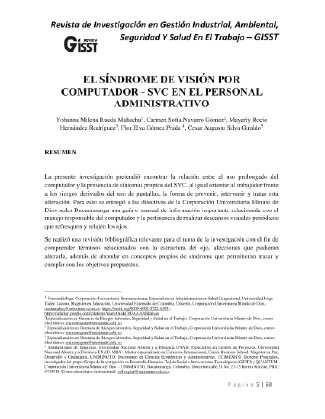III. COMPUTER VISION SYNDROME - CVS IN ADMINISTRATIVE PERSONNEL
##plugins.themes.bootstrap3.article.main##
Abstract
This research aimed to find the relationship between the prolonged use of the computer and the presence of symptoms typical of SVC, as well as to orient the worker regarding the risks derived from the use of screens, the way to prevent, intervene and treat this alteration. For this purpose, a guide or manual with important information related to the responsible use of the computer and the relevance of taking periodic visual breaks to refresh and relax the eyes was given to the directors of the Corporación Universitaria Minuto de Dios Bucaramanga headquarters.
A bibliographic review relevant to the topic of the research was carried out in order to understand terms related to the structure of the eye, affections that could alter it, as well as to delve into concepts of the syndrome that would allow to trace and fulfill the proposed objectives.
Having determined the above, the survey was chosen as an assessment instrument, which consisted of 22 questions that were applied to a sample of 33 workers in which their habitual behavior in front of the computer and its use was studied in depth.
From the analysis of the results obtained it was possible to establish subjectively the presence of symptoms typical of BMS, this information was correlated with the results of the optometric exams looking for more objective information with which the symptoms were confirmed.
Download Statistics
##plugins.themes.bootstrap3.article.details##
Computer Vision Syndrome, Occupational Risks
Consulte Logros Vive Digital 2010 - 2015 Disponible en: http://www.mintic.gov.co/portal/604/w3-propertyvalue-546.html
Contextualización, P., & de Apoyo, L. (2010). Entornos Laborales Saludables: Fundamentos y Modelo de la OMS. Disponible en: http://www.who.int/occupational_health/evelyn_hwp_spanish.pdf
Declara de Helsinhi Disponible en: https://www.unisabana.edu.co/fileadmin/Documentos/Investigacion/comite_de_etica/Declaracion_Helsinki_2013.pdf
Del Río Martínez, J., & González Videgraray, M. (2007). Trabajo prolongado con computadoras: consecuencias sobre la vista y la fatiga cervical. México, DF: SEMAC, 26-28. Disponible en: http://www.semac.org.mx/archivos/9-47.pdf
Echeverri Saldarriaga, Sara; Giraldo Ochoa, Daniela; Lozano García, Lucas; Mejía, Paula Andrea; Montoya LLano, Luisa; Vásquez Trespalacios, Elsa María. Síndrome de visión por computador una revisión de sus causas y del potencial de prevención. Localización: Revista CES Salud Pública, ISSN-e 2145-9932, Vol. 3, Nº. 2, 2012, págs. 193-201
Estepa, A. P. C., & Iguti, A. M. (2013). Síndrome de la visión del computador: diagnósticos asociados y sus causas. Ciencia & Tecnología para la Salud Visual y Ocular, 11(2), 97-109. Disponible en: http://revistas.lasalle.edu.co/index.php/sv/article/view/2504
Formas de mejorar la calidad de la visualización. Disponible en: http://windows.microsoft.com/es-xl/windows/improve-display-quality#1TC=wind
García Álvarez, P. E., & García Lozada, D. (2010). Factores Asociados con el Síndrome de Visión por el uso de Computador. Investigaciones Andina, 12(20), 42-52. Consultado en Febrero 2014, Disponible en:http://www.scielo.org.co/scielo.php?pid=S0124-81462010000100005&script=sci_arttext
Guía GTC 45 del 2012, última actualización.
Guía técnica para la evaluación y prevención de los riesgos relativos a la utilización de equipos con Pantallas de visualización. Edición 2006, Real decreto 488/1997. Disponible en: http://www.insht.es/InshtWeb/Contenidos/Normativa/GuiasTecnicas/Ficheros/pantallas.pdf
Historia Mundial de la Salud Ocupacional. Universidad Nacional Abierta y a Distancia, Disponible en: thttp://datateca.unad.edu.co/contenidos/102505/102505_Primera_Unidad_-_Actualizada/leccin_1_historia_mundial_de_la_salud_ocupacional.html
Asociación Armonie Serie Cuadernos de Apoyo 2007 - Nº 3. Compendio de Definiciones: Síndromes elaborado por María Cecilia Claramunt. Disponible en: www.poder-judicial.go.cr/.../de-su-interes?...compendio-de-definiciones-...
St, Louis, Missouri, Diccionario de Medicina Océano Mosby. 4 Edición, España. MCMXCIV by Mosby- Year Book, Inc.
Journal Epidemool Community Healt, 2004;58:1021-1027 doi:10.1136/jech.2003.018127, Dr. Masayuki Tatemichi, de la Toho University School of Medicine de Tokio, Disponible en: http://jech.bmj.com/content/58/12/1021
Lámpara fluorescente. Disponible en: http://www.ecured.cu/index.php/L%C3%A1mpara_fluorescente
Medrano Muñoz, Sandra Milena. (2009). Estado acomodativo en usuarios de computador: Manejo optométrico. Disponible en: http://revistas.lasalle.edu.co/index.php/sv/article/view/1078/980
Ministerio de Telecomunicaciones. Logros. Disponible en: http://www.mintic.gov.co/portal/604/w3-propertyvalue-546.html
Norma NTP 204: Videoterminales: evaluación subjetiva de las condiciones de trabajo, para incluir otros aspectos de las condiciones de trabajo. (1988). Disponible en: http://www.insht.es/InshtWeb/Contenidos/Documentacion/FichasTecnicas/NTP/Ficheros/201a300/ntp_204.pdf
Norma Técnica Colombiana NTC 5831 de 2010
NTP 174: Exploración oftalmológica específica para operadores de pantallas de visualización (P.D.V.). Disponible en: http://www.insht.es/InshtWeb/Contenidos/Documentacion/FichasTecnicas/NTP/Ficheros/101a200/ntp_174.pdf
NTP 196: Videoterminales: evaluación ambiental. Disponible en: http://www.insht.es/InshtWeb/Contenidos/Documentacion/FichasTecnicas/NTP/Ficheros/101a200/ntp_196.pdf
NTP 211: Iluminación de los centros de trabajo. Disponible en: http://www.insht.es/InshtWeb/Contenidos/Documentacion/FichasTecnicas/NTP/Ficheros/201a300/ntp_211.pdf
NTP 252: Pantallas de Visualización de Datos: condiciones de Iluminación. Disponible en: http://www.insht.es/InshtWeb/Contenidos/Documentacion/FichasTecnicas/NTP/Ficheros/201a300/ntp_252.pdf
Organización Internacional de Estandarización 1992- ISO 9241-3 Ergonomic requirements for office work with visual display terminals (VDTs)
Pantallas de visualización de datos, José Alberto Sanz Marinero. INSHT Instituto Nacional de Seguridad e Higiene en el trabajo. 1996.
Pantoja, J. J., Nova, O., Bohórquez, J. C., & Peña, N. M. (2011). Caracterización de emisiones y susceptibilidad radiada de un computador personal. Revista de Ingeniería, (33), 25-33. Disponible en: http://www.scielo.org.co/scielo.php?pid=S0121-49932011000100004&script=sci_abstract
Resolución 8430 de 1993 Disponible en: https://www.minsalud.gov.co/Normatividad_Nuevo/RESOLUCION%208430%20DE%201993.pdf
Saldarriaga, S. E., Ochoa, D. G., García, L. L., Mejía, P. A., LLano, L. M., & Trespalacios, E. M. V. (2012). Síndrome de visión por computador: una revisión de sus causas y del potencial de prevención. Revista CES Salud Pública, 3(2), 193-201. Disponible en: http://dialnet.unirioja.es/servlet/articulo?codigo=4163389
Tatemichi, Masayuki; Nakano, Tadashi; Tanaka, Katsutoshi; Hayashi, Takeshi; Nawa, Takeshi; Miyamoto, Toshiaki; Hiro, Hisanori; Sugita, Minoru. 2004. Possible association between heavy computer users and glaucomatous visual field abnormalities: a cross sectional study in Japanese workers. Disponible en: http://jech.bmj.com/content/58/12/1021
Lentes de Computador, Recurso Nacional Canadiense de Seguridad y Salud Ocupacional. 2001. Disponible en: http://www.ccsso.ca/oshanswers/ergonomics/office/computer_glasses.html
Ustinavičienė, R., Obelenis, V., & Ereminas, D. (2004). Occupational health problems
in modern work environment. Medicina (kaunas), 40(9), 897-904.
Disponible en: http://europepmc.org/abstract/med/15456978

